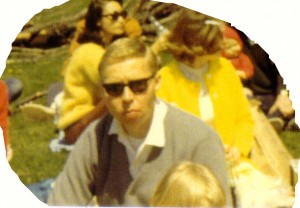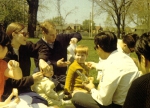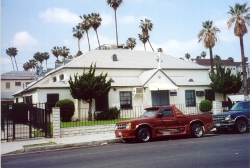During the week of August 9, 1970, nine eighteen-foot rental vans were picked up from Hertz on Olympic Boulevard in Los Angeles, California, were loaded with furniture and personal belongings, and were driven to Chicago.
The Need for Migration
About one year earlier, during the fall of 1969, an International Conference was held in the Embassy Auditorium in Los Angeles at which time Witness Lee spoke of the need for the migration of brothers and sisters to certain major cities in the United States. One city that was mentioned was Chicago, Illinois.
After the conference, some who shared the same burden began to meet every Saturday evening to pray and fellowship concerning the matter of migration, particularly to Chicago.
During the spring of 1970 (March 22-27), Jim Reetzke and three other brothers went to Chicago to “spy out” the land. During their visit they considered the layout of the city, looking for a strategic place to settle with the whole city and nearby suburbs in view. Jim applied and interviewed for jobs in teaching or administration at Elmhurst College, Northeastern University, and the Hinsdale and Oak Park school districts. In June, a second visit by Jim to Oak Park secured him a job in District 97. As it turned out, he was the only one with a job among all those who migrated to Chicago in 1970.
Following the visit to Chicago, another International Conference was held on July 17, 1970, again at the Embassy Auditorium in Los Angeles. At this time Jim Reetzke was asked to share with everyone what the brothers experienced while in Chicago and what was their realization concerning a migration to that city. He shared about the rectangular layout of the city and how the different expressways are like arteries connecting the various parts of the city and, in turn, branching out to include the suburbs. The unanimous feeling was that surely the Lord needed a proper testimony in that city and that some would migrate there. After this meeting Witness Lee told Jim Reetzke, “You are a pioneer for a second time,” because Jim had been in Los Angeles during the pioneering days of the ’60s. (See the author’s history of the church in Los Angeles in Recollections with Thanksgiving: A Brief History of the Beginnings of the Lord’s Recovery in the United States.)
The Participants
All together, 20 families (Andersons, Bowens, Coles, Dongs, Higgins, Johnsens, Kangases, Karnes, Klopfensteins, Leagues, Littles, McGranahans, Moores, Ostings, Phinneys, Reetzkes, Scroggins, Ulickis, Wilbanks, Yoders) and four single people (Mike Broadie, Frank Clark, Ruth Johnson, Jerry Sanza) took part in the migration to Chicago for a total of 42 adults and 38 children. All of these had lived in Los Angeles for varying lengths of time, and all met at the meeting hall of the church in Los Angeles at 1101 S. Elden that was known as Elden Hall.
Elden Hall
The Move
All of the rental vans had until August 20 to load up belongings, make the trip, find a place to live, and unload in Chicago. Vans were grouped with cars to make up a total of six caravans. Most drivers drove straight through with little stopping along the way. One van did not arrive until the 29th of August. Everyone witnessed the Lord’s guiding and protective hand. One time, in particular, could have presented a serious problem. One Volkswagen bus broke down and got separated from its caravan. One of the vans went back 250 miles, attached the bus to the rear of the truck, and towed it the rest of the way to Chicago. One car had trouble after arriving, but this happened right by a Chevy garage. The last van to arrive (on the 29th) had experienced trouble with one of the cars in its caravan before leaving Los Angeles. After the needed repairs had been made, the caravan started for Chicago.
Jim Reetzke arrived on the 12th of August and began to look for places in which the families and singles could live. Three different rental agencies were contacted, but nothing opened up. Then by the weekend, when the families and single ones started to arrive, we saw the Lord’s providing hand at work.
The Lord’s Provision
Many stayed, initially, at the Leaning Tower Y.M.C.A. or with friends in the area. At the rear of the Y.M.C.A., the rental vans could be seen all in a row. The Y.M.C.A. was a new structure then, nine stories high. On the ninth floor was a large meeting area from where one could look out in different directions through eight sets of windows at the city of Chicago.
A View for Prayer
During the first morning when most were there, Isaiah 26:1-4 was pray-read. When the phrase, “Open ye the gates,” was read, everyone stood before each set of windows in turn and shouted this command in every direction toward the city, “Open the gates and let the righteous ones enter.” Our confidence was in the Lord.
Except for the two families (Littles and Ulickis) that lived in the Irving Park area, all of the other families and singles found apartments just south of the Kennedy Expressway and west of Cumberland. At that time, a large number of new apartment buildings had just been completed, and some were still under construction. Each apartment building was three stories high with six apartments ranging from one to three bedrooms. The owner allowed six of the families to move into one building even though it had not been fully completed. One of those was a family of eight and was allowed to put in an extra room in the basement in exchange for some custodial care.
Facing this apartment building was another with only one apartment of the six rented. This took care of five more families. This was surely the Lord’s way of providing for the needs. So many places that were considered would not take children or were not suitable for children. Others would only take one or two children at most. Some families had three, four, five, and even six children. The Lord softened the heart of the owner-builder, McNerney, and made him willing to accept these families. The basements were used to store the contents of some of the trucks that needed to be emptied so they could be turned in. These basements were quite large. Older apartment buildings nearby had only half the basement area. The same building owner, McNerney, was also helpful in the opening of bank accounts and was even willing to let his name be used for personal references. The Reetzkes (Jim Sr. and Jim Jr.) rented an apartment nearby and gave hospitality to one of the families, a family of four, until they were able to move into their own apartment. Doubling up was quite common until everyone found a place to stay. In one two-bedroom apartment, three families stayed together! Some stayed for a short time at the Y.M.C.A. in Niles. Little by little, most of the families found housing in the Irving Park area of the city.
Initially, none of the brothers except Jim Reetzke had a job, but gradually everyone was provided for.
Meeting Places
After the initial meeting place at the Leaning Tower Y.M.C.A. in Niles, homes of families we had come to know in the area were used. The first meeting of the church in Chicago was held on September 10, and the first Lord’s Table was on the Lord’s Day, the 13th of September.
In October 1970, a storefront at 4516-18 W. Irving Park was rented and remodeled for use. Brother Witness Lee came in October for a conference with the church. He came again for a conference in 1971 from August 27 to September 6. This storefront was used for meetings until the city of Chicago said that the building could no longer be used for church meetings. Twice the church went before the zoning board, and twice a request for a variance was refused.
For the years 1972, 1973, and part of 1974, the church met alternately between the Portage Park American Legion Hall, the Irving Park Y.M.C.A., and the basement of St. John’s Episcopal Church.
In June 1974, a large three-story building that had been the Rogers Park Masonic Temple (1716 W. Lunt) was purchased by the church. Almost every window had been broken out, and much needed to be done before it could be used. This property was sold in the fall of 1979.
For the next two years the church met in the Arlington Heights school district.
Irving Park Road
From the winter of 1979 until the spring of 1983, the second floor of the Ace Hardware, 3933 W. Irving Park, was the meeting place of the church. A parking lot at 3921 W. Irving Park was the first piece of property the church purchased on Irving Park. It was purchased from Herschberg Ford in January 1981. The first meeting place on Irving Park (3915-19) to be purchased by the church was obtained in March 1981. It was last used as a machine shop and became a vacant and much-neglected building. After much renovation it was in use by the spring of 1983 as a meeting place of the entire church. Later it became a hall for the Chinese-speaking members.
A three-story building at 3913 W. Irving Park was the next to be purchased in July 1983. The second- and third-floor apartments were used for meetings of the Spanish speaking and the children. The Korean speaking met on the first floor.
In July 1984, the property at 3925-27 was purchased and became the main meeting hall.
Earlier in May 1980, the six-flat at 3929-31 W. Irving Park was purchased by some of the church members because of its closeness to where the church was meeting and because of the potential it offered. Later there was a transfer of title to the church. This is the present site of the bookstore operated by the church, Chicago Bibles and Books. The apartments provide housing accommodations for Christian workers.
The last piece of property on Irving Park purchased by the church was at 3911. This was in January 2000.
Demolition and construction for the present hall at 3925 W. Irving Park were begun in March 2002, and the building was completed for use by June 2003.
Moving On
In the years following the initial migration in 1970, some of the migrants who came at that time were burdened to move to other cities. Those cities included Detroit, St. Louis, Minneapolis, Indianapolis, Milwaukee, and Philadelphia. This also included the nearby cities of Hanover Park, Naperville, and Palatine.
—Jim Reetzke


